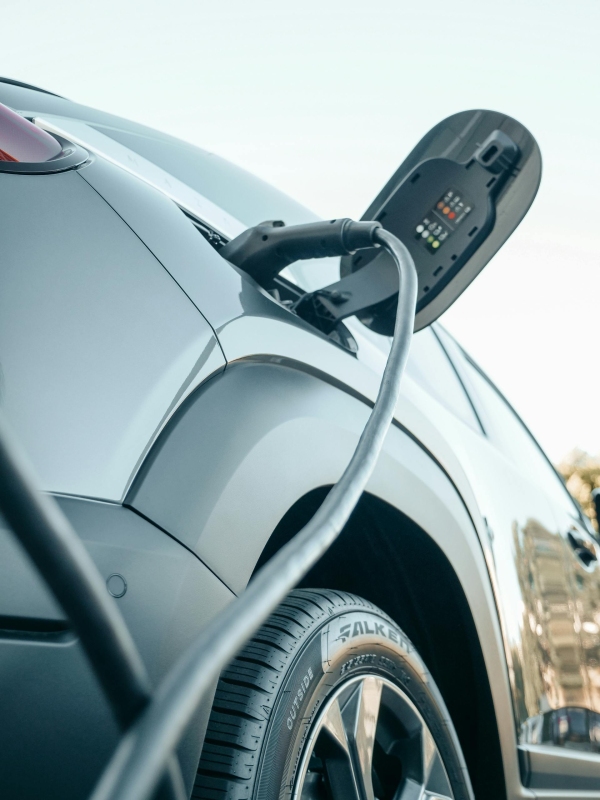Driving the vehicle for change: what opportunities are there for landowners when it comes to the expansion of electric vehicles?
Transport is the largest contributor to the UK’s greenhouse gas emissions. With ambitions to meet its net-zero target by 2050, the Government has committed to ending the sale of new petrol and diesel cars and vans by 2030. Many motorists will therefore be considering purchasing an electric vehicle as their next car or utility vehicle.
The driven expansion of electric vehicle ownership brings with it a need for a greater density of charging infrastructure, presenting commercial opportunities for landowners.
Private use
The need for private home-installation is clear. The Government has recommended that all new homes should have a charge point available and considerable funding has been pledged to support installation.
Housebuilders are being encouraged to deliver installation points not only by altruistic motives to improve standards of living and realise the environmental benefits, but with a view to increasing the value of their developments. Certain types of charging point might also secure the prospect of receiving a long-term income beyond the point of sale. Others may find they are required to provide charging point facilities under section 106 agreements or as a condition of sale.
Retrofitting charging points into existing homes is likely to be at a slower pace and increase with consumer-incentive. When it comes to fitting charging points, homeowners will need to consider best placement and be careful to avoid infringing other rights.
Where accommodation is let, landlords wishing to install charging points will need to think carefully about what land is within their control and whether tenants’ consent is required. Whilst landlords might see installation to be only a benefit, the existence of infrastructure will bring with it a future requirement for maintenance and repair works, which could be disruptive. It could also have an impact on electricity capacity, either of which could expose the landlord to complaints or even legal claims.
Whilst the existence of facilities might on the one hand be seen to enhance the amenity value of a property, installation may result in a reduction of space available for other users or facilities. Strategic placement will therefore be key.
In other cases, landlords may find they themselves receive requests from tenants to install infrastructure which will in turn feed into discussions about responsibilities and funding. In February 2021, the funding schemes were expanded to those living in leasehold and rented accommodationto enable individuals to receive up to £350 towards installation costs; however future upkeep will need to be considered and documented.
Under the Work Place Charging Scheme, businesses may also apply for a grant to reduce the cost of having an EV charging point installed at their premises, to enable staff to charge from their place of work. To further encourage private investment, from February 2021 small businesses and those in the charity sector are also now able to access that funding. It is hoped this will also widen charge point services beyond the cities and into more rural areas.
Public use
Beyond investment in the private sector, the Government is aiming for the concentration of network infrastructure to be such that motorists will always be within a 30-mile range of a charging point, requiring a host of public facilities.
There are currently over 35,000 public charge point connectors across the UK which increased by over 7,000 in 2020 alone – yet many more will be needed. Widening the availability and visibility of infrastructure will undoubtedly assist in improving consumer confidence in electric vehicles, lessening so called “range anxiety” – the consequence of the current more limited mileage of electric vehicles compared to traditional combustion engine vehicles.
Where should we be looking?
The question landowners should be asking is where do people want to be able to charge their vehicles from and is this something they can offer?
Akin to charging their mobile phones, consumers want to be able to access charging facilities when it is convenient and easy to do so, without having to go out of their way or make a separate trip to the petrol station as with traditional vehicles.
This requires the careful deployment of infrastructure not only on the highway and in car parks, but close to workplaces, supermarkets, gyms, restaurants or outdoor attractions. It is probable that getting ‘ahead of the curve’ by installation of infrastructure could encourage more visitors to use their amenities over others or welcome visitors back. The influence of convenience should not be underestimated.
Landowners with broader portfolios will want to consider where is best to situate charging facilities – where is the greatest footfall, where demand is highest, as well as where costs are going to be most economical. For example, certain types of chargers will have a lower connectivity cost to the grid where there is closer proximity to existing infrastructure.
Agreements
Once a site has been identified for charging point installation, conversations with electric vehicle installers and developers can follow.
Securing a power supply from the grid is essential– this is amidst some predictions fearing there will be insufficient grid capacity if installation is not managed in a strategic manner. This will generally be for the landowner to arrange.
Once established, the charge point itself will then be installed and ‘run’ by an operator. There are a growing number and variety of operating companies which install public charging points and landowners will need to investigate these to decide who is the best commercial partner for them, assuming they are not approached directly.
When it comes to documenting an agreement, one option is the ‘traditional’ lease model, with the landowner leasing the site to an operator in exchange for a rent. The operator will pay for the charger to be installed and the parties will agree on commercial terms and carve out responsibilities for the future.
Another option is the adoption of a ‘concession agreement’ in which the landowner will retain ownership of the site but will grant an operator the right to install and operate the charging point from it. Structuring the agreement in this manner has its benefits as it can better address the responsibilities of the parties and eradicate ‘unnecessary’ traditional leasehold terms.
Such terms do not necessarily suit this more modern arrangement and could lead to unforeseen issues for landlords, such as alienation provisions. For example, if a landlord has been careful to select its operating partner, under a lease arrangement there is a risk if an assignment takes place the landowner could find itself contracting with a completely different entity. This is a particular risk given the rapid expansion of the operator market and the number of new companies entering the arena.
As with any property agreement, the precise terms and any rental will be matters for negotiation and will depend on the nature of the parties involved as well as the purpose and perceived benefits of the charging point site.
For example, is the site intended as a means of “attraction” to that destination (e.g. retail spaces) increasing the amenity value, or is its purpose purely useful (such as on the highway)? In former cases, you might find rental income comprises a ‘base rent’ based on actual use but is otherwise likely to be based upon the use of the site and what a tenant is willing to pay for the right to operate the charging points.
Parties will also need to carefully consider the future need to upgrade the equipment. Operators will inevitably need to respond to developments in technology. The duration of the agreement will need to strike a balance between upfront investment cost and having that ability to respond to growth – as well as the possibility that demand at a particular location might not be as anticipated. A particular unknown is whether there will be a return to shopping outlets post-pandemic, where there has been a significant shift towards online retail.
As well as this, consideration will also need to be given to matters such as planning, preparation of licences and whether there are any health & safety issues. Specialist advice should be sought.
There may also need to be consideration to issues arising under the Electronic Communications Code. A Section 106 direction has, for example, been given to Liberty Global Europe 3 Limited (the parent company of Virgin Media). The application to OFCOM was submitted to help support the provision of an electronic communications network for the specific aim of deploying 1,200 charging points across the Country.
Conclusion
It is inevitable that the evolution of electric vehicles is going to require the support of the landowning community to facilitate the rollout of charging facilities. For this, there will need to be forward planning and innovative, tailored agreements to document deals.
It’s an exciting time for landowners who should be ready to embrace and address this new wave of technology as well as maximise the new opportunities which this offers to them.

LEEDS
One Park Row
Leeds,
West Yorkshire
LS1 5AB
Phone: +44 (0) 113 856 0446
Email: hello@hagenwolf.co.uk
Web: www.hagenwolf.co.uk
LONDON*
One Pancras Square
King's Cross
London
N1C 4AG
Phone: +44 (0) 207 846 4146
Email: hello@hagenwolf.co.uk
Web: www.hagenwolf.co.uk
NEWCASTLE*
Bank House
Pilgrim Street
Newcastle
NE1 6QF
Phone: +44 (0) 113 856 0446
Email: hello@hagenwolf.co.uk
Web: www.hagenwolf.co.uk
*‘We do not take service at our London and Newcastle offices. All meetings, at all of our offices, are by appointment only.
Hägen Wolf Limited (trading as Hägen Wolf) are solicitors of England and Wales authorised and regulated by the Solicitors Regulation Authority SRA Number 659328. Details of the Solicitors Code of Conduct can be found at www.sra.org.uk Hägen Wolf Limited is registered at Companies House No. 10830060. Registered Office: One Park Row, Leeds, LS1 5AB. We use the word 'partner' to refer to a shareowner or director of the company, or an employee or consultant who is a lawyer with equivalent standing and qualifications.
Site by: elate global
Contact us
Give us a call on 0330 320 1440 or send us an email at hello@hagenwolf.co.uk or fill in the boxes below and pop over a quick message and a member of the team will get back to you as soon as they're free.




